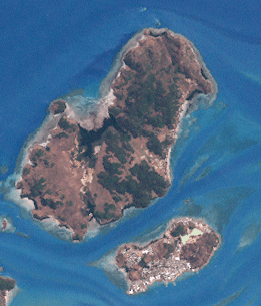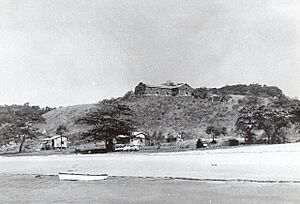Hammond Island (Queensland) facts for kids
Quick facts for kids Hammond IslandQueensland |
|
|---|---|

Hammond and Thursday, Torres Strait
|
|
| Population | 261 (2021 census) |
| Postcode(s) | 4875 |
| Time zone | AEST (UTC+10:00) |
| LGA(s) | Torres Strait Island Region |
| State electorate(s) | Cook |
| Federal Division(s) | Leichhardt |
Hammond Island is an island and a town in the Torres Strait, Queensland, Australia. Its Indigenous name is Keriri or Kiriri. It is the only island in the area known as Keriri Island. This area is part of the Torres Strait Island Region local government. In 2021, 261 people lived on Hammond Island. Most of them (96.9%) were Indigenous Australians.
Contents
A Glimpse into Hammond Island's Past
The Kaurareg people have lived on Hammond Island, which they call Keriri, for a very long time. They were here before Europeans arrived. Hammond Island is in the southern part of the Torres Strait. For thousands of years, the Kaurareg hunted, fished, and farmed. They also traded with Aboriginal groups from Cape York. These strong connections still exist today.
First European Visitors
In August 1791, Captain Edwards of HMS Pandora named the island Hammond Island. He was sailing through the Torres Strait. In 1802, British navigator Matthew Flinders sailed past the island. He saw campfires but did not meet the Kaurareg people.
In 1864, a government settlement started at Somerset on Cape York. The police there were often unfriendly to the Aboriginal people and the Kaurareg.
Early Conflicts and Changes
In April 1869, the crew of a ship called Sperwer was killed near Prince of Wales Island. Government officials believed the Kaurareg people were responsible. Some Kaurareg men were captured and executed. Later, more attacks happened against the Kaurareg people.
Life on Hammond Island: 1900-1950
Many Kaurareg people were moved to Hammond Island in the early 1900s. By 1913, about 80 Kaurareg people lived there. They were from different islands near Thursday Island.
The government wanted the Hammond Islanders to move to Moa Island. But the Kaurareg people did not want to leave. They did not get schools or medical help on Hammond Island. In 1914, many people died when the flu spread through the community.
By the 1920s, the Queensland Government decided to move the Kaurareg people from Hammond Island. They built new homes on Moa Island. In March 1922, the Kaurareg community was forced to move to Moa Island. Police arrested three people who protested the move.
The Catholic Mission on Hammond Island
From the 1880s, many Filipino workers in the Torres Strait married local Aboriginal and Torres Strait Islander women. These marriages were often done by the Catholic Church. In the 1920s, the government did not like mixed-race families on Thursday Island.
In 1928, the Catholic Church got permission to start a mission on Hammond Island. This mission was for families with Filipino backgrounds. St Joseph’s Catholic mission opened in 1929. Catholic priests and nuns ran the mission. Families from other islands also moved there. St Joseph's School opened in 1935. The school closed during World War II when people left the island. Nuns reopened the school in 1950, but it closed again in 1963.
Islander Rights and World War II
In 1936, many Torres Strait Islander workers went on strike. They were protesting government control over their lives. This strike led to important changes. Islander council representatives were elected and consulted by the government. These new island councils had some control over local police and courts.
In 1937, representatives from 14 Torres Strait communities, including Hammond Island, met. In 1939, the Queensland Government passed the Torres Strait Islander Act 1939. This law officially recognized Torres Strait Islanders as a separate people from Aboriginal Australians.
During World War II, people living on Hammond Island had to leave. They went to a convent in southeast Queensland. The army used the mission buildings on the island. An RAAF radar station operated there from 1942 to 1943.
Hammond Island: 1950-2000
After World War II, the pearling industry became less important. Islanders could then work and live on Thursday Island and the Australian mainland. Some mission residents returned to Hammond Island. They found that white ants had destroyed their church.
Work began on a new Catholic church. In 1952, St Joseph’s Church was built on a hill. It used local stone and was built by volunteers. Materials were brought by pearl luggers (boats). In 1964, the priest and nuns moved to Thursday Island.
After Papua New Guinea became independent in 1975, it wanted some Torres Strait islands. A plan was made to divide the Torres Strait. But the Queensland Government and Torres Strait Islanders did not agree. In 1978, Australia and Papua New Guinea signed a treaty. This treaty set the borders and rules for using the sea.
The Torres Strait Treaty started in 1985. It allows free movement between both countries without passports or visas. This free movement is for traditional activities like fishing, trading, and family gatherings. These activities happen in a special "Protected Zone." This zone also helps protect the land, sea, and animals of the Torres Strait.
Recent Times: 2001-Present Day
Our Lady of the Sacred Heart School opened in 2002.
Who Lives on Hammond Island?
In 2016, 268 people lived on Hammond Island. 251 (93%) of them were Indigenous Australians. In 2021, the population was 261 people. 253 (96.9%) of them were Indigenous Australians.
Education on Hammond Island
Our Lady of the Sacred Heart School is a private primary school. It teaches students from Prep to Year 3. It is located on Church Street. Older children take a ferry every day to Thursday Island. They attend the main school there.
Community Facilities
The Torres Strait Island Regional Council runs the Hammond Island Indigenous Knowledge Centre. It is on Wonie Road. St Joseph the Worker's Catholic Church is part of the Thursday Island Parish. This parish belongs to the Roman Catholic Diocese of Cairns.



